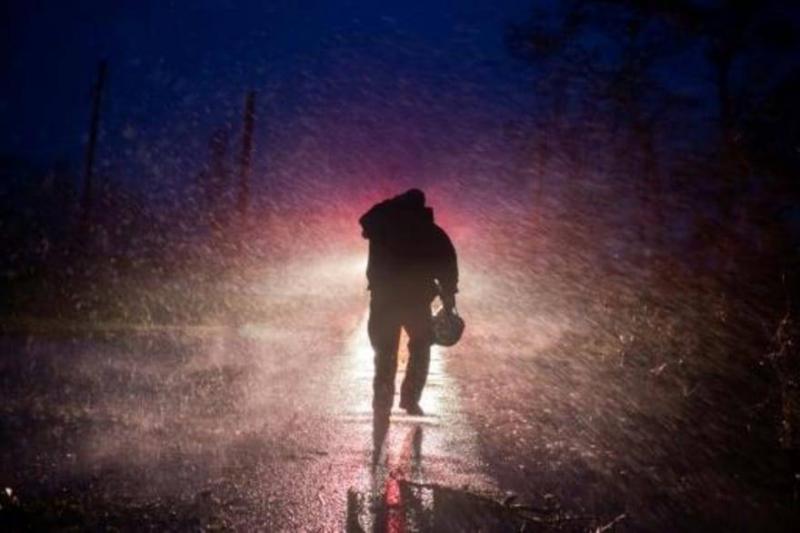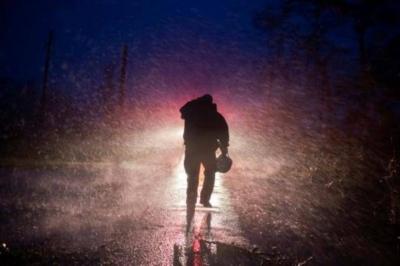Hurricane "Ida" struck the U.S. state of Louisiana, plunging New Orleans into darkness on Sunday and causing the death of one person, 16 years and one day after Hurricane Katrina devastated the city. Ida made landfall in Louisiana as a Category 4 storm but weakened to a Category 1 by Monday morning. The storm caused a blackout across New Orleans and affected over a million people throughout Louisiana, according to the specialized site "PowerOutage.US." New Orleans Mayor LaToya Cantrell tweeted, "We no longer have power at the city level! You need to stay in safe places. This is not the time to be out!"
The power company "Entergy" stated that it is supporting the "New Orleans Sewerage and Water Board" with power, enabling it to operate water pumping stations to manage flooding. The National Weather Service issued warnings of storms and flooding in several areas, including the town of Jean Lafitte, south of New Orleans, where Mayor Tim Kerner reported that rising water levels led to breaches in levees. Kerner told "WGN" affiliated with "ABC," "Complete destruction and disaster, (the waters) exceeded our town's levees." He reported, "We have 75 to 200 people stranded in Barataria," after a suspended bridge connecting the island to the mainland collapsed. He added, "The winds are still extremely strong; we cannot lower boats into the water to reach them." Kerner emphasized, "We have a small group trying to rescue the most vulnerable individuals. It is a very dangerous situation. I have never seen this much water in my life."
U.S. President Joe Biden, who described Ida as "a life-threatening storm," announced that Louisiana is experiencing a "major disaster," which allows it to receive federal assistance. One person was killed by a falling tree in Prairieville, located about 60 miles northwest of New Orleans, according to the Ascension Parish Sheriff's Office. Torrential rains and fierce winds swept through the deserted streets of New Orleans in the morning, shaking the windows of fortified shops and homes surrounded by sandbags. Louisiana Governor John Bel Edwards suggested that Ida could be the strongest storm to hit the state since 1850. He stated in a briefing on Sunday, "There is no doubt that the days and weeks ahead will be extremely difficult," adding that some may need to stay in safe places for up to 72 hours. He previously tweeted, "Find the safest place in your homes and stay there until the storm passes."
Many residents responded to the warnings of catastrophic damage and the authorities' evacuation orders. Highways leading out of New Orleans were congested with cars in the days leading up to Ida’s landfall. In one neighborhood in East New Orleans, some residents were seen completing their preparations hours before the storm reached land. Charles Fields, who was moving his garden furniture indoors, said, "I'm not sure if I'm ready... but all we can do is ride it out." The 60-year-old man, whose home was flooded with 10.8 feet of water during Hurricane Katrina in 2005, added, "We’ll see how it goes."
Governor Edwards warned on Sunday that Ida would pose "a very dangerous test for our levee systems," which include an extensive network of pumps, gates, and earthen and concrete barriers that have been reinforced since Katrina. CNN reported that hundreds of thousands of residents are believed to have been evacuated. He stated that the storm "poses significant challenges for us at a time when hospitals are overcrowded with COVID patients." Louisiana, where vaccination rates are low, is among the states most affected by the pandemic, putting immense pressure on hospitals. The number of cases requiring hospitalization reached 2,700 on Saturday, close to the numbers recorded at the peak of the pandemic.
The memory of Katrina, which made landfall on August 29, 2005, is still vivid in the minds of Louisiana residents, as that storm claimed around 1,800 lives and caused damages estimated in the billions of dollars. Edwards stated earlier, "Thinking about a strong storm like Hurricane Ida making landfall on this anniversary is extremely painful." Rainfall is expected to reach 10 to 18 inches in parts of southern Louisiana until Monday, and even higher in some areas. As of 1:00 AM Monday, the storm had winds of up to 75 mph but is expected to weaken as it moves inland, likely heading north toward the central U.S. before turning east to reach the Mid-Atlantic region by Wednesday.
The White House announced on Sunday that federal agencies deployed more than 2,000 emergency personnel to the area, including 13 specialized search and rescue teams in urban areas, along with supplies of food, water, and generators. The White House added that local authorities, the Red Cross, and other organizations have set up dozens of shelters accommodating at least 16,000 people. Scientists have warned of increasing hurricane activity due to rising ocean surface temperatures caused by climate change, which poses a growing threat to coastal populations worldwide.




